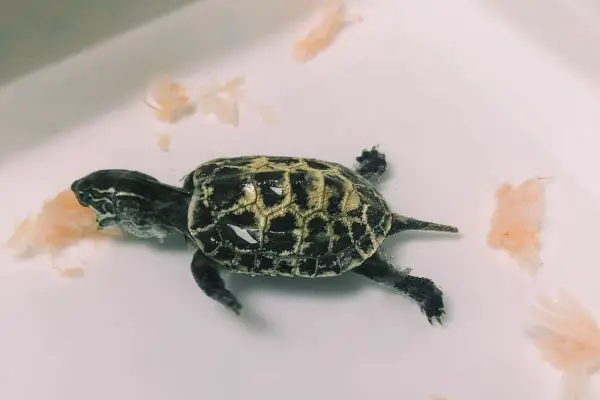2 Amazing Turtle Science Fair Projects: Explore Feeding & Navigation!
Who would have thought that a quiet, humble little creature dawdling and paddling around could participate in a marvelous science fair project?
Better yet, there are turtle science fair projects that don’t even require you to have a turtle, as you’ll see below.
But what makes these reptiles so fascinating (and ideal for scientific research)?
The thing is, we still haven’t exactly figured out a lot of their behavior and instinct. Scientists are still studying them, and we still don’t know how freshly-hatched, beach baby turtles instinctively navigate themselves into the water.
Besides that, we can learn a lot from them about magneto-reception, biological classification, orientation and navigation, and feeding schedules of animals.
2 Interesting Turtles Science Fair Activities for All Ages
#1 Navigate Like a Turtle (Without a Turtle)
Age range: 5-10 | Elementary School
Turtle navigation is one of the most perplexing problems in Herpetology. But it’s also a mysterious topic that’s still being researched by quantum biologists all around the globe.
Before you start thinking: yes, quantum biology is a thing! It lies at the intersection of quantum mechanics and theoretical chemistry.
Quantum biology tries to explain natural occurrences that defy the natural laws of physics. Surprisingly or not,turtle navigation is one of the most researched topics in this field.
Turtles travel by following the magnetic fields of the Earth. They have a magnetoreceptor sense, which can lead them to the same beach they hatched!
In the past 50 years, scientists have speculated many things:
- Maybe turtles have a 6th sense when it comes to magnetic fields?
- Maybe they inherited a gene on magnetic fields?
- Maybe they have magnetite in their skeletal tissues?
For all we know, turtles might be aliens!
We, as humans, do not have this ability (yet). So the best way to understand turtle navigation is to try and replicate it with a few magnets and a compass.
For this experiment, your kid will need an adult helper!
What they WON’T need is an actual turtle.
Materials needed:
- A small room;
- 10 different size magnets;
- Compass for everyone playing;
- An adult helper;
- Timer.
Procedure:
- Have an adult hide the 10 magnets around the room.
- Prepare the timer.
- Grab a compass, and enter the room.
- Once you enter the room, turn on the timer and count the time.
- Search around the room and try to find the magnets.
- Collect the 10 magnets.
- Stop the timer, and write down the time.
The magnetic field of the magnets interferes with the compass by pulling the needle towards themselves. When a compass needle is surrounded by strong magnets it can’t show the true north. So it spins and goes crazy!
The compass in this case represents the turtle. There have been many experiments with hatchlings and their navigation. But they would be unsafe to do at home or in a school lab. The magnets disoriented the hatchlings and made them swim in a different direction than usual.
This experiment can be modified in many ways:
- You can use different magnets with different strengths;
- You can use faulty compasses, which won’t show where the magnets are.
- It can be done with many people;
- It can be done outside.
In conclusion, this short experimental game gives you a taste of magnetoreception and allows you to navigate the way turtles do!
#2 Turtle Feeding Schedule
Age range: 10-13 | Middle School
Whether in the wilderness or captivity, turtles are diurnal animals, and they do not function like other reptiles.
In the oceans, a lot of nocturnal animals are predators. And turtles do not have any defense mechanisms to protect themselves from them.
Turtles have amazing eyesight during the day, hunting see through jellyfish without any difficulties. But when it comes to night vision, it isn’t developed at all!
In order to protect themselves, they evolved into 100% diurnal creatures which allowed them to live that long.
When it comes to feeding, they will eat anything that looks easy to catch: jellyfish, shrimps, small fish, and sometimes plants.
They feed during the day when the sun illuminates the water.
Turtles in captivity aren’t surrounded by dangerous predators, so they can change their feeding time if they feel safe.
With this in mind, you can balance their food intake and make them feel safer in their aquarium.
Materials needed:
- A turtle (if you don’t have a pet turtle, ask a turtle owner if you can borrow their turtle or tortoise for a science experiment);
- Feeding schedule;
- Turtle food;
- Pen and paper.

Procedure:
- Create a diverse schedule for feeding, for example Monday at 9 PM, Tuesday at 7 AM, and so on.
- Follow the schedule for a week. Regarding your turtle’s age, feed them the right amount of food:
- Baby turtles up to 1 year – 1 time a day.
- Young adult turtles – every second day.
- Mature turtles – every third day.
- Every time you feed the turtle, write a short report on their behavior.
- After finishing the experiment, compare the reports from every feeding and find the best time for feeding them!
You can alter their food, and see how they react to different vegetables, fruits and herbs.
By knowing your turtle’s behavior, and feeding schedule, you can provide them with enough food at the right time to make them feel safer. Who knows, they might even want to experience the fun nightlife!
Bottom Line
From navigation to feeding, turtles are an enigma.
There are a lot of things about turtles that are still unknown to us, what we know proves that they are 250 million years older than dinosaurs and slowly they’re going extinct one by one.
The fact that 6 out of 7 species of sea turtles are endangered, and some of the reasons include global warming, pollution, and the exotic animal trade, tells us everything we need to know about turtles.
If we want to learn more from them, the most important thing to do right now is to make a difference, and there are many ways we can save them.
Bonus: Weird & Fascinating Facts about Turtles
Any of these could inspire you to come up with your own turtle science fair projects!
- They travel more than 10,000 miles every year.
- Not all turtles are docile! Some are pretty vicious creatures, such as snapping turtles! (Not the best candidate for your science fair project…) They can even eat water snakes.
- They are one of the oldest animal species on this planet.
- They are also prone to living to a ripe old age. Some have a lifespan of up to 150 years!
- The female lays more than 100 eggs in one nest. Sadly, only one in 1,000 hatchlings survives in nature.
- They have a great memory: they remember underwater cities, where to hide, and where to look for food.
- Different temperatures affect turtle eggs. Colder beaches produce all-male turtles, and warmer beaches produce all-female turtles.
- If you’re fascinated by these facts, you might want to take a look at this sea turtle satellite tracking project!
Frequently Asked Questions
What do I need to know before buying a pet turtle?
Turtles have a lifespan of 15-25 years. So if you want a partner in crime for a longer period, you should consider purchasing a turtle!
They are the Michael Phelps of pets, so they need a semi-aquatic aquarium. They need to be in a bigger aquarium with at least 50-60 gallons of volume, with a water-to-land ratio of 75% to 25%.
They need an acclimated tank with heat bulbs and special thermometers for water and air. Keeping their surroundings at optimal temperature is crucial for their survival.
They can carry various diseases dangerous to humans, and they are sensitive to the bacteria we carry on our skin. So wash your hands before and after handling them!
Do turtles have an exoskeleton?
The short answer is no!
Turtles do not have an exoskeleton. They are vertebrates and their shell – carapace is made out of their vertebrae and ribs. It also has a sturdy layer of the epidermis that forms an interesting mosaic.
Fun fact: every turtle has a unique carapace (shell), and it’s considered to be the fingerprint of turtles.
What’s the difference between turtles and tortoises?
Both turtles and tortoises are part of one order – Testudines, but they aren’t the same.
Turtles are half-aquatic animals. Their body is hydrodynamic and they can endure more water pressure, with flippers specially adapted for swimming. So, they can’t spend a lot of time on land.
On the other hand, tortoises are terrestrial animals with rounder shells and fully functional legs adapted for walking on all kinds of surfaces. Tortoises can hide their head and legs in their shells, but turtles do not have this ability!
They eat different kinds of foods too. Turtles enjoy small fish, jellyfish, and lots of algae, while tortoises prefer munching on flowers, fruits, and vegetables.
In other words, trust not your eyes, but the official scientific classifications!








